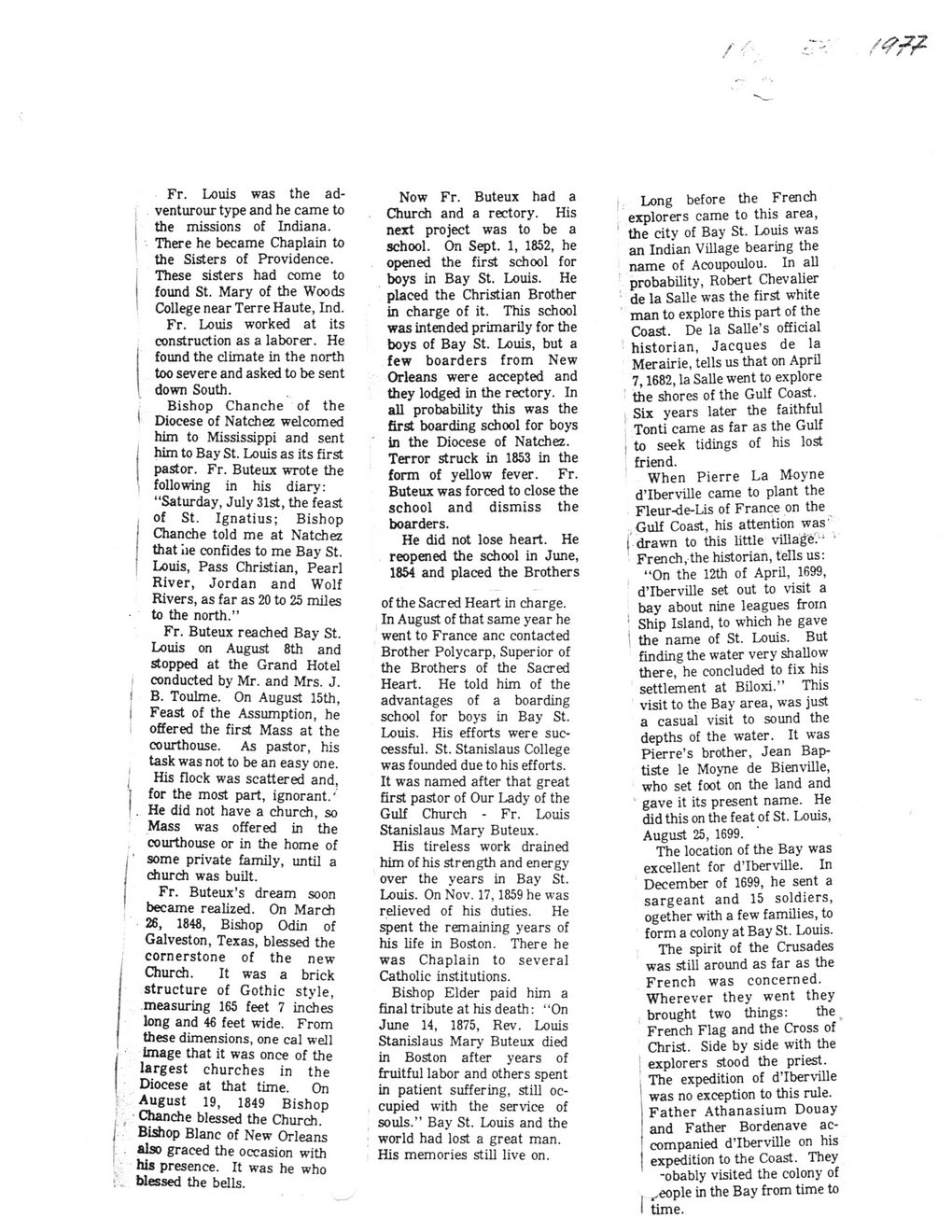This text was obtained via automated optical character recognition.
It has not been edited and may therefore contain several errors.
/, Fr. Louis was the ad-venturour type and he came to the missions of Indiana. There he became Chaplain to the Sisters of Providence. These sisters had come to found St. Mary of the Woods College near Terre Haute, Ind. Fr. Louis worked at its construction as a laborer. He found the climate in the north too severe and asked to be sent down South. Bishop Chanche of the t Diocese of Natchez welcomed him to Mississippi and sent I him to Bay St. Louis as its first pastor. Fr. Buteux wrote the following in his diary: “Saturday, July 31st, the feast of St. Ignatius; Bishop • Chanche told me at Natchez ' that lie confides to me Bay St. Louis, Pass Christian, Pearl River, Jordan and Wolf Rivers, as far as 20 to 25 miles to the north.” Fr. Buteux reached Bay St. Louis on August 8th and stopped at the Grand Hotel conducted by Mr. and Mrs. J. ; B. Toulme. On August 15th, i Feast of the Assumption, he I offered the first Mass at the courthouse. As pastor, his task was not to be an easy one. | His flock was scattered and, ] for the most part, ignorant/ I. He did not have a church, so Mass was offered in the courthouse or in the home of ' some private family, until a church was built. Fr. Buteux’s dream soon became realized. On March 26, 1848, Bishop Odin of Galveston, Texas, blessed the cornerstone of the new Church. It was a brick structure of Gothic style, measuring 165 feet 7 inches long and 46 feet wide. From these dimensions, one cal well image that it was once of the largest churches in the Diocese at that time. On August 19, 1849 Bishop Chanche blessed the Church. Bishop Blanc of New Orleans also graced the occasion with his presence. It was he who blessed the bells. Now Fr. Buteux had a Church and a rectory. His next project was to be a school. On Sept. 1, 1852, he opened the first school for boys in Bay St. Louis. He placed the Christian Brother in charge of it. This school was intended primarily for the boys of Bay St. Louis, but a few boarders from New Orleans were accepted and they lodged in the rectory. In all probability this was the first boarding school for boys in the Diocese of Natchez. Terror struck in 1853 in the form of yellow fever. Fr. Buteux was forced to close the school and dismiss the boarders. He did not lose heart. He reopened the school in June, 1854 and placed the Brothers of the Sacred Heart in charge. In August of that same year he went to France anc contacted Brother Polycarp, Superior of the Brothers of the Sacred Heart. He told him of the advantages of a boarding school for boys in Bay St. Louis. His efforts were successful. St. Stanislaus College was founded due to his efforts. It was named after that great first pastor of Our Lady of the Gulf Church - Fr. Louis Stanislaus Mary Buteux. His tireless work drained him of his strength and energy over the years in Bay St. Louis. On Nov. 17,1859 he was relieved of his duties. He spent the remaining years of his life in Boston. There he was Chaplain to several Catholic institutions. Bishop Elder paid him a final tribute at his death: “On June 14, 1875, Rev. Louis Stanislaus Mary Buteux died in Boston after years of fruitful labor and others spent in patient suffering, still occupied with the service of souls.” Bay St. Louis and the world had lost a great man. His memories still live on. I Long before the French . explorers came to this area, the city of Bay St. Louis was an Indian Village bearing the name of Acoupoulou. In all probability, Robert Chevalier de la Salle was the first white man to explore this part of the Coast. De la Salle's official historian, Jacques de la Merairie, tells us that on April 7,1682, la Salle went to explore the shores of the Gulf Coast. Six years later the faithful Tonti came as far as the Gulf i to seek tidings of his lost friend. When Pierre La Moyne d’lberville came to plant the Fleur-de-Lis of France on the Gulf Coast, his attention was’ | drawn to this little village?* French, the historian, tells us: i “On the 12th of April, 1699, d’lberville set out to visit a ( bay about nine leagues from ' Ship Island, to which he gave | the name of St. Louis. But finding the water very shallow there, he concluded to fix his settlement at Biloxi.” This visit to the Bay area, was just a casual visit to sound the depths of the water. It was Pierre’s brother, Jean Baptiste le Moyne de Bienville, who set foot on the land and gave it its present name. He did this on the feat of St. Louis, August 25, 1699. The location of the Bay was excellent for d’lberville. In December of 1699, he sent a sargeant and 15 soldiers, ogether with a few families, to form a colony at Bay St. Louis. The spirit of the Crusades was still around as far as the French was concerned. Wherever they went they brought two things: the^ French Flag and the Cross of Christ. Side by side with the j explorers stood the priest. , The expedition of d’lberville was no exception to this rule, i Father Athanasium Douay and Father Bordenave ac-1 companied d’lberville on his I expedition to the Coast. They -obably visited the colony of . ^eople in the Bay from time to I time.

Our Lady of the Gulf Church Document (152)